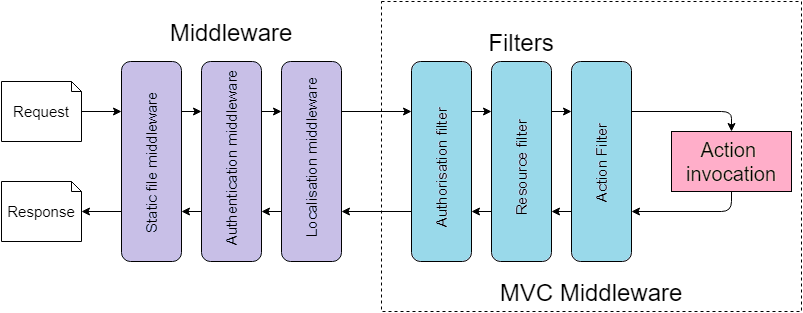Filters vs Middleware in ASP.NET Core
In .NET Core, both filters and middleware can be used to add additional functionality to an HTTP request pipeline. However, there are some differences between the two:
- Filters are used to add functionality that is specific to an action method or controller, whereas middleware is used to add functionality that is applied to all requests passing through the pipeline.
- Filters are executed in a specific order, based on their type (authorization filters, action filters, result filters, etc.), whereas middleware is executed in the order it is added to the pipeline.
- Filters can access and modify the action context and arguments, whereas middleware can only modify the HTTP context.
- Multiple filters can be applied to a single action method, whereas only one middleware can be applied to a single request.
- There are many built-in filters in .NET Core, such as authorization filters, action filters, exception filters, and resource filters, but middleware is more flexible and allows developers to create their own custom middleware.

In general, if you need to add functionality that is specific to a controller or action method, then filters may be the best choice. If you need to add functionality that applies to all requests passing through the pipeline, then middleware may be the best choice.
Following are some examples of when you might use filters and middleware in .NET Core
Filters:
- Authorization: we can use an authorization filter to verify that a user is authorized to access a particular action method or controller.
- Caching: we can use a caching filter to cache the response of an action method, so that subsequent requests can be served faster.
- Logging: we can use a logging filter to log information about each request and response.
- Validation: we can use a validation filter to validate the input to an action method, to ensure that it meets certain criteria.
- Exception handling: we can use an exception filter to catch exceptions thrown by an action method and handle them appropriately.
Middleware:
- CORS: we can use middleware to add CORS (Cross-Origin Resource Sharing) support to your application, so that it can be accessed from other domains.
- Static files: we can use middleware to serve static files, such as HTML, CSS, and JavaScript files, from your application.
- Session management: we can use middleware to manage user sessions, so that user data can be persisted across requests.
- Compression: we can use middleware to compress the response of an HTTP request, to reduce the amount of data that needs to be transferred.
- Authentication: we can use middleware to handle user authentication, such as verifying user credentials and creating authentication tokens.
Overall, both filters and middleware provide a powerful mechanism for adding additional functionality to your .NET Core application's HTTP request pipeline.
4 Comments









great work!
Nicebot
10-Oct-2023 at 06:33